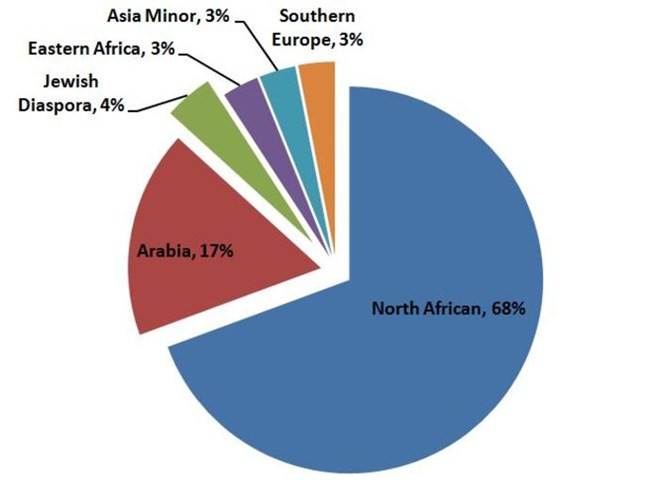Shocked DNA analysis: Most Egyptians are not Arabs
After more than 10 years of analyzing DNA samples from hundreds of people, the National Genome Project (NGGP) has revealed an amazing fact that most Egyptians are not Arab-based as most people think. .
This study provides charts showing the specific global gene structure for each country, shedding light on the question of the origins of ethnic groups, races and common origins of human communities.
According to the study, only 17% of Egyptians are Arabs , while 68% are indigenous people from the North African region, 4% have Jewish ancestors, 3% are from East Africa , 3% from Asia Minor and 3% from Southern Europe.
The NGGP study was conducted based on the analysis of native Egyptians. According to the study, the ancient people migrated from Africa and stopped for the first time in East North Africa, then moved down to the Southwest Asia region.

According to research, only 17% of Egyptians are Arabs.
In Egypt, North Africans and Arabs have formed a characteristic community on ancient migration paths as well as subsequent migrations, including migration from the "fertile crescent moon" (calendar land). history in the Middle East incorporating ancient Egypt, Levant and Mesopotamia, returned to Africa, migrating in the 7th century with the spread of Islam from the Arabian Peninsula and the development of transparent agriculture 10,000 years.
The East African element in the Egyptian gene map shows the exchange of ancient communities living along the Nile, while the South European and Asian Minor elements reflect Egypt's historical and geographical role. an important part of the economic and cultural development of the Mediterranean region.
The study also showed that Kuwaiti DNA samples were mainly Arab-based with 84%, 7% from Asia Minor, 4% from North Africa and 3% from East Africa.
According to NGGP, ancient migrants came to the Middle East when moving from Africa to Asia, some decided to stay and genetically inherit their descendants. Meanwhile, a small percentage of people originated from North and East Africa to the Middle East due to slave trade in Arab countries popular from the 8th to 9th centuries.
Lebanon is the most diverse country among Arab countries, with 44% of Arab descent, 14% of Jewish descent, 11% of North African origin, 10% of Minor Asian, 5% of Southern European and only 2% from East Africa.
Tunisia has the lowest rate of Arab descent with 4%, while there are 88% of North African descent, 5% of Western Europe, and 2% of West and Central Africa.
- Not only NASA, Arabs also aspire to bring people to Mars
- Find the lost picture of Delacroix
- 6 things we do not know about the people of ancient Egypt
- The new DNA analysis technology promises to shorten the time of detention
- DNA analysis: Outlined the culprit's face
- How to transport stone to build pyramids of ancient Egypt
- The reason why the Egyptians worship the beetles eat dung
- The first mobile wastewater analysis station in Vietnam
- 'Hunt down' the medical secret of ancient Egyptians
- Ancient Egyptians were good seafarers
- Ancient Egyptians love to eat pork
- Ancient Egyptians made jewelry from meteorites
 'Fine laughs' - Scary and painful torture in ancient times
'Fine laughs' - Scary and painful torture in ancient times The sequence of numbers 142857 of the Egyptian pyramids is known as the strangest number in the world - Why?
The sequence of numbers 142857 of the Egyptian pyramids is known as the strangest number in the world - Why? History of the iron
History of the iron What is alum?
What is alum? Could 20 pitbulls survive for a week if placed in the African savannah?
Could 20 pitbulls survive for a week if placed in the African savannah?  There are only 1,300 people left in the world: The 'apocalyptic' escape is real!
There are only 1,300 people left in the world: The 'apocalyptic' escape is real!  Learn about Africa
Learn about Africa  What are the salient features of the African climate?
What are the salient features of the African climate?  Medical waste can spread monkeypox virus
Medical waste can spread monkeypox virus  Warning of two nCoV strains that can cause a new wave of infections
Warning of two nCoV strains that can cause a new wave of infections 